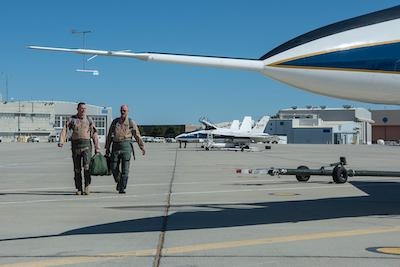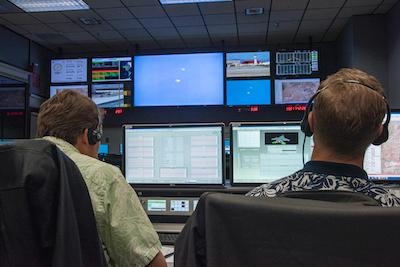Agency Is Applying A 21St Century Twist To Early Research Methods
NASA recently completed flight testing of a state-of-the-art instrument designed to capture high-quality measurements of shock waves created by supersonic aircraft in flight. It’s called the Shock Sensing Probe. The probe’s performance was tested in flight at NASA’s Armstrong Flight Research Center in Edwards, California, using an innovative technique originated by NASA’s predecessor, the National Advisory Committee for Aeronautics.

Through the first half of the 20th century, those pioneering researchers led the world into a golden era of aeronautical breakthroughs and achievement, especially in the development of supersonic flight, or flight that is faster than the speed of sound. Today, NASA is applying a 21st century twist to those early research methods as it flies the Shock Sensing Probe to prepare for the planned 2021 delivery of the X-59 Quiet SuperSonic Technology aircraft.
Now under construction by Lockheed Martin in Palmdale, California, the X-59 is an experimental supersonic jet whose mission is to help enable a future in which commercial faster-than-sound flight over land is possible. Before that can become a reality, however, NASA will utilize its historic flight research expertise to observe, analyze and validate the X-59’s shock waves – waves of air pressure that occur whenever an aircraft flies at supersonic speeds, and are heard on the ground as a loud sonic boom.
The key to the X-59’s success will be its ability to fly at supersonic speeds without generating the standard shock waves that result in the annoyingly loud sound of a sonic boom heard by people on the ground.
NASA will use the Shock Sensing Probe to accurately observe the various characteristics of the X-59’s shockwaves and confirm whether they match the agency’s models to be able to reduce the sound of a sonic boom to a quiet thump. “The X-59 is going to have specific shock waves that we predict will sound much quieter on the ground than your standard sonic boom,” said Shock Sensing Probe Project Manager Kevin Weinert. “We’ve developed a system to be able to measure those shock waves and confirm they are what we’re expecting. We’re validating that we can collect this data when the X-59 flies.”
Flying NASA’s Shock Sensing Probe now is giving engineers an opportunity to test the probe in conditions similar to what will be experienced during X-59’s validation flights in the future.
To do this, NASA used a technique dating back to the 1940s and commonly used by the NACA – combining two instruments together and mounting them onto the nose of an aircraft to measure the pressure of shock waves from another aircraft.
During the recent flight tests, the Shock Sensing Probe instrument was mounted onto the end of an NACA-style nose boom, which is a pole that extends from the nose of an aircraft – in this case, a NASA F-15 research jet.
The F-15 joined a NASA F/A-18 research jet in the sky, with both aircraft flying at speeds up to Mach 1.3, or about 1,000 mph. The Shock Sensing Probe on the F-15 was then used to measure the supersonic shockwaves coming off the F/A-18. “We were capturing pressure measurements, looking at the changes in pressure as we flew into and out of the shock waves,” said Mike Frederick, NASA’s Principal Investigator for Shock Sensing Probe.
“Essentially, we had the F/A-18 as the lead aircraft, flying supersonic so it was creating shock waves, with the F-15 lined up off the F/A-18’s wing. In that position, the F-15 is actually in front of the lead aircraft’s shock waves, and we had the F-15 decelerate, and then reaccelerate, through the F/A-18’s shocks back and forth multiple times, with the probe collecting measurements.”

NASA researchers completed two probing flights, flying both aircraft at approximately 42,000 feet, with the F-15 taking multiple measurements from both 500 and 300 feet of separation. This approach allowed the pilots to practice the maneuver at further distances and work their way closer. It also provided a rich set of data, as shock wave features change the further away they are measured from the shock-generating vehicle.
The next step is to compare the recorded data of the shock waves to existing computer models of the F/A-18 in flight, which predict how the shock waves will look. This will help researchers determine how accurately the probe was able to measure them. “We have the computational fluid dynamics models for the F/A-18, which is why we chose this aircraft for this flight series,” said Frederick. “It gives us the ability to confirm how closely the shocks measured by the Shock Sensing Probe match our model for the F/A-18.”
Basically, the closer the data recorded by the Shock Sensing Probe are to NASA’s models, the more accurate the probe was able to capture that data. The cone-shaped Shock Sensing Probe itself contains five “pressure ports” – holes that are in place to measure the pressure on the surface around the instrument, which is shaped like a cone. As the F-15 flies through the shockwaves coming from the F/A-18, the five pressure measurements are combined to calculate the changes in air pressure. The Shock Sensing Probe effort is a continuation of previous research projects, including 2016’s Eagle Aero Probe flights, which provided valuable lessons learned, leading to critical upgrades to the probe.
One such upgrade was to the quality of data, which was achieved by boosting the speed at which the probe was able to collect that data.
Previous probing booms featured up to 15 feet of pneumatic tubing, resulting in a lag in the time it took for the signal of the measurements to actually be transmitted through the tubing, which could throw off the data. In comparison, today’s Shock Sensing Probe features sensors that are within four inches of the pressure ports on the cone, resulting in the signal being transmitted nearly instantaneously, which improved the data.
NASA’s team is taking lessons learned from the first phase of Shock Sensing Probe flights to improve the design for the project’s second phase, expected to take place in early 2020. These improvements include enhancements to the team’s ability to regulate the instrument’s temperature, which can change based on flight conditions and speed, affecting the probe’s ability to measure pressure. By keeping the probe at a stable temperature during flight, the data will be more repeatable and consistent. Meanwhile, newly designed pressure transducers have improved the data’s resolution. “The X-59 will feature unique shock waves, in which the changes in pressure are extremely small, so we need to have a very high resolution to be able to measure those,” explained Frederick.
The ultimate goal of those pressure measurements, combined with others that will be taken after the X-59 begins its flight tests, is to be sure the aircraft is performing as expected by producing quieter sonic booms.
Today, aircraft are prohibited from flying supersonic over land, primarily due to the loudness of sonic booms produced by aircraft above moving faster than the speed of sound. The X-59 is designed to fly at supersonic speeds while producing shock waves in such a way that the typically loud sounds of sonic booms may sound no louder than a nearby car door being closed.
While the restriction on supersonic flight over land is currently based on the aircraft’s speed, NASA research using the X-59 is intended to provide data that will enable regulators, such as the Federal Aviation Administration, to establish new rules that are based on sound, not speed.
That data will be created by flying the X-59 over several communities and recording the public’s perceptions of the noise they hear, if at all, through the use of official surveys.
Although the X-59 is not a prototype of a new commercial supersonic airliner, its sonic boom quieting technology will be shared with industry, which – along with potential rule changes by the FAA and others – could lead to a new era of faster-than-sound travel and substantially reduced flight times.
The Shock Sensing Probe flight series is flown under the Flight Demonstrations and Capabilities project, or FDC, within NASA’s Aeronautics Research Mission Directorate. FDC is one of three projects, along with the Commercial Supersonic Technology and Low Boom Flight Demonstrator projects, supporting the effort to demonstrate quiet supersonic flight, which, as NASA’s aeronautics program has done since its early days as the NACA, can change the way we fly. “If there’s a flight experiment involving complicated systems, or a flight test that’s high risk, that’s what FDC has set out to do,” said FDC Project Manager Brent Cobleigh. “Our role is to increase the technology readiness level for new technologies and go out and fly them.”
(Images provided with NASA news release)
 ANN's Daily Aero-Term (04.24.24): Runway Lead-in Light System
ANN's Daily Aero-Term (04.24.24): Runway Lead-in Light System ANN's Daily Aero-Linx (04.24.24)
ANN's Daily Aero-Linx (04.24.24) Aero-FAQ: Dave Juwel's Aviation Marketing Stories -- ITBOA BNITBOB
Aero-FAQ: Dave Juwel's Aviation Marketing Stories -- ITBOA BNITBOB Classic Aero-TV: Best Seat in The House -- 'Inside' The AeroShell Aerobatic Team
Classic Aero-TV: Best Seat in The House -- 'Inside' The AeroShell Aerobatic Team Airborne Affordable Flyers 04.18.24: CarbonCub UL, Fisher, Affordable Flyer Expo
Airborne Affordable Flyers 04.18.24: CarbonCub UL, Fisher, Affordable Flyer Expo




